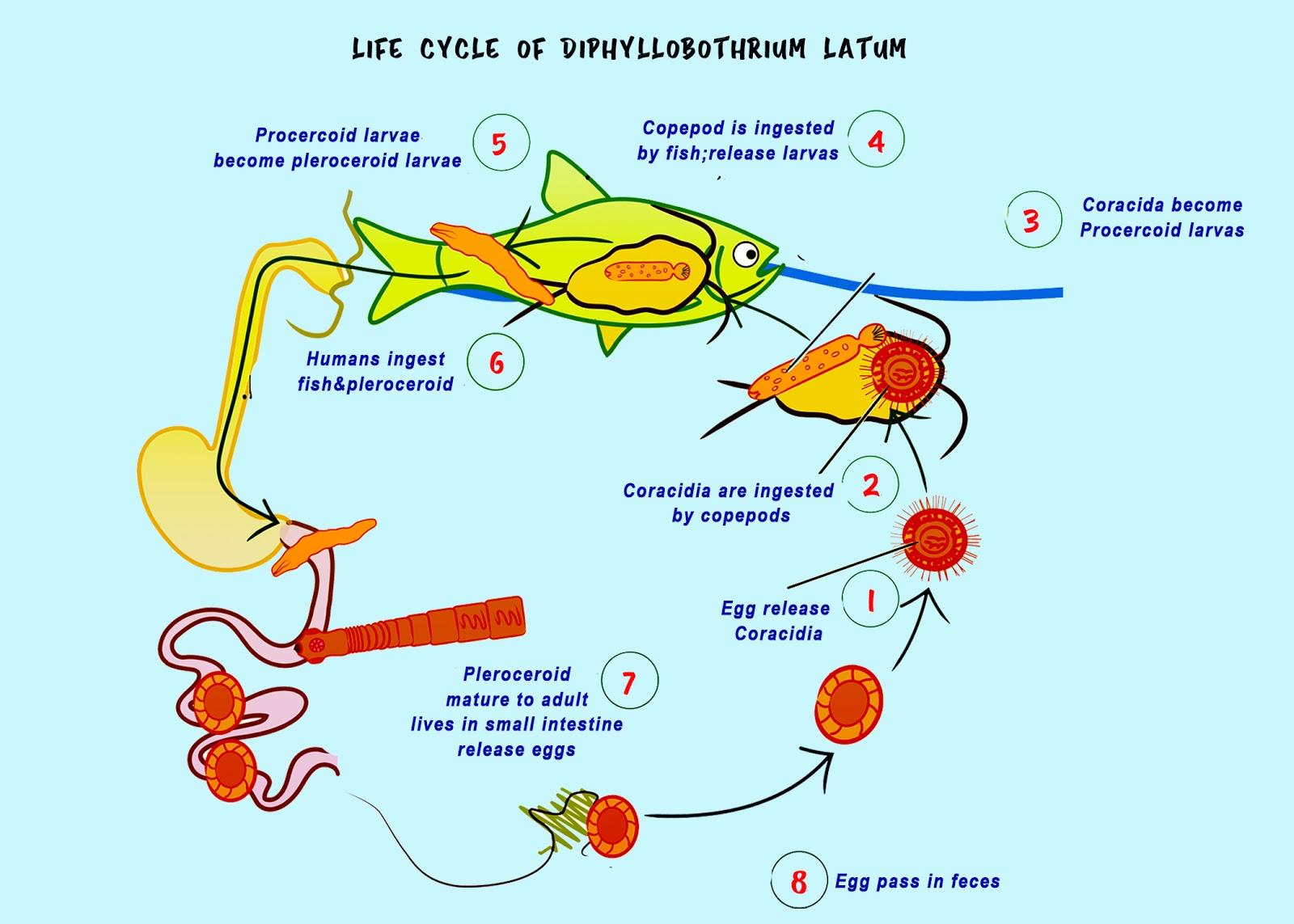
Which of the following is commonly known as fish tapeworm?
(a) Taenia solium
(b) Taenia saginata
(c) Diphyllobothrium latum
(d) Dipylidium caninum
Answer
549k+ views
Hint: This organism belongs to a group of tapeworms. Fish tapeworms also tend to cause diphyllobothriasis in humans through the consumption of raw or undercooked fish.
Complete answer:
Diphyllobothrium latum is also known as the fish tapeworm which infects humans. It is a long parasite that lives in the intestine of humans and can achieve a length of more than 10 m (33 feet). The life cycle of D. latum continues by requiring feces of infected hosts that are discarded into freshwater bodies, containing the appropriate crustacean and fish intermediate hosts. If this infected fish is eaten raw by definitive hosts then it gets infected with diphyllobothriasis. Humans are the easiest hosts for this species of tapeworm, although it may include bears, dogs, and other carnivores which can serve as reservoir hosts. It is seen that adult worms do not cause any major disease, although they may compete with the host for the absorption of vitamin B12 from the intestinal lumen. This can cause megaloblastic anemia in the body of the host, although this is now rarely seen.
Additional Information
The adult stage of D. latum shows white to ivory coloration and can grow up to 10–12 m long. Size can also vary according to the host species in which it lives. The scolex (the anterior end of a tapeworm, bearing suckers and hooks for attachment) of the adult worm has two shallow and elongated grooves called bothria that are used for attachment to the intestinal mucosa.
The proglottids (segments in the strobila of a tapeworm, containing a complete sexually mature reproductive system) generally develop in the neck region and increase in size and maturity toward the posterior end. Proglottids that reach the maturation stage are broader than long, and each contains one set of male and female reproductive organs.
So according to the question, the principal species causing diphyllobothriasis is Diphyllobothrium latum which is also known as the fish tapeworm.
Note: D. latum parasites can survive 30 years or maybe more. Additionally, multiple tapeworms can be seen in the same patient. Normally, infection is asymptomatic. Nonspecific symptoms include weakness, dizziness, salt craving, diarrhea, and intermittent abdominal discomfort.

Complete answer:
Diphyllobothrium latum is also known as the fish tapeworm which infects humans. It is a long parasite that lives in the intestine of humans and can achieve a length of more than 10 m (33 feet). The life cycle of D. latum continues by requiring feces of infected hosts that are discarded into freshwater bodies, containing the appropriate crustacean and fish intermediate hosts. If this infected fish is eaten raw by definitive hosts then it gets infected with diphyllobothriasis. Humans are the easiest hosts for this species of tapeworm, although it may include bears, dogs, and other carnivores which can serve as reservoir hosts. It is seen that adult worms do not cause any major disease, although they may compete with the host for the absorption of vitamin B12 from the intestinal lumen. This can cause megaloblastic anemia in the body of the host, although this is now rarely seen.
Additional Information
The adult stage of D. latum shows white to ivory coloration and can grow up to 10–12 m long. Size can also vary according to the host species in which it lives. The scolex (the anterior end of a tapeworm, bearing suckers and hooks for attachment) of the adult worm has two shallow and elongated grooves called bothria that are used for attachment to the intestinal mucosa.
The proglottids (segments in the strobila of a tapeworm, containing a complete sexually mature reproductive system) generally develop in the neck region and increase in size and maturity toward the posterior end. Proglottids that reach the maturation stage are broader than long, and each contains one set of male and female reproductive organs.
So according to the question, the principal species causing diphyllobothriasis is Diphyllobothrium latum which is also known as the fish tapeworm.
Note: D. latum parasites can survive 30 years or maybe more. Additionally, multiple tapeworms can be seen in the same patient. Normally, infection is asymptomatic. Nonspecific symptoms include weakness, dizziness, salt craving, diarrhea, and intermittent abdominal discomfort.

Recently Updated Pages
Master Class 12 Business Studies: Engaging Questions & Answers for Success

Master Class 12 Economics: Engaging Questions & Answers for Success

Master Class 12 English: Engaging Questions & Answers for Success

Master Class 12 Maths: Engaging Questions & Answers for Success

Master Class 12 Social Science: Engaging Questions & Answers for Success

Master Class 12 Chemistry: Engaging Questions & Answers for Success

Trending doubts
What is meant by exothermic and endothermic reactions class 11 chemistry CBSE

Which animal has three hearts class 11 biology CBSE

10 examples of friction in our daily life

One Metric ton is equal to kg A 10000 B 1000 C 100 class 11 physics CBSE

1 Quintal is equal to a 110 kg b 10 kg c 100kg d 1000 class 11 physics CBSE

Difference Between Prokaryotic Cells and Eukaryotic Cells




